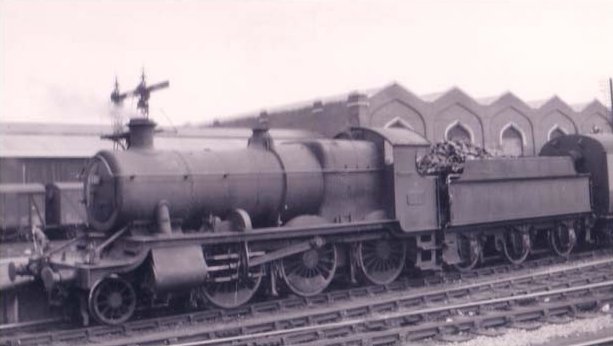- GWR 4300 Class
Infobox Locomotive
name = Great Western Railway 4300 Class
powertype = Steam
caption = 6381 atSouthampton Terminus 1949
builder =Great Western Railway ,Swindon Works ,Robert Stephenson and Company (35)
builddate = 1911–1932
totalproduction = 342
whytetype =2-6-0
uicclass = 1'C
gauge = RailGauge|ussg|lk=on
leadingsize = convert|3|ft|2|in|m|3|abbr=on
driversize = convert|5|ft|8|in|m|3|abbr=on
length = convert|58|ft|1+1/4|in|m|2|abbr=on
axleload = convert|17.60|LT|lk=on
weight = convert|102.00|-|105.30|LT
waterc
convert|3500|impgal|lk=on
fuelc
convert|7|LT
cylindercount = Two, outside
cylindersize = convert|18.5|x|30|in|mm|0|abbr=on
boilerpressure = convert|200|psi|MPa|2|abbr=on|lk=on
tractiveeffort = convert|25670|lbf|kN|2|abbr=on|lk=on
railroad =Great Western Railway ,British Railways
roadnumber = 4300–4399, 5300–4399, 6300–6399, 7300–7321, 9300–9319
firstrundate = 1911
locale =Great Britain
powerclass=GWR: D; BR: 4MT
axleloadclass = GWR: 4300–7300s Blue; 8300–9300s: Red
retiredate = 1936–1964TheGreat Western Railway (GWR) 4300 Class is a class of2-6-0 (mogul)steam locomotive .__TOC__Overview
The class was introduced in
1911 to aG.J. Churchward design. 342 were built until1932 . They were initially numbered in the 4300-99, 5300-99, 6300 - 6399 and 7300 - 7321 ranges.The 4300 Moguls were the maid of all work on the GWR network and later the western region Employing a Standard number 4 boiler and the support struts similar to those fitted to the '2800' class, it very quickly earned an excellent reputation in its ability to handle most types of traffic, from local stopping goods to main line expresses.
The first twenty that were built remained slightly different from the rest of the class in that the frames of all other production engines were lengthened by 9 inches at the rear to give more access to the plumbing as well as more room in the cab.
88 were withdrawn and the wheels and motion of 80 were used for the Grange Class and 8 for Manor Class engines but the advent of the
Second World War in1939 stopped the conversions. It also helped standardise parts and thus made repairing the engines easier.Eleven examples of the class were transported to France during World War I in the service of the Railway Operating Division of the British Army and these were 5319 - 5326 and 5328 - 5330. Of which one survives in preservation.
Of the 342 engines built only two survive in preservation.
Modifications to the class
In 1925 7300-7304 were modified for better balance and had detail alterations.
Between January and March 1928, due to problems with wear of the
flange s of the leadingpony truck , 65 engines of 5300 series received additional weight on the pony truck.In 1932,
Charles Collett modified the original design and introduced 9300 - 9319 with side window cabs, outside steam pipes and a screw reverse .5300--99 were renumbered 8300-399 between 1944 and 1948. After passing into
British Railways ownership, the Collett locos 9300-19 were modified back to light buffer beam design and were renumbered 7322-7341 between1956 and1959 .6320 was converted to oil firing between
1947 and it was removed in1949 .The last were withdrawn in
1964 .Preservation
Only two have survived to preservation:
5322 is the oldest of the two as it was built in 1917, during the great war, at Swindon works. Almost at once when it was rolled out it, and several other classmates, was immediately sent to France for hauling munitions and hospital trains. There it was painted in War Department livery and given the number ROD5322. Demobbed in 1919 at Chester it returned to the GWR fleet till it was withdrawn from service April 1964. It was sent to Barry Scrapyard and thus ended up in preservation as the sole early 43xx to be preserved. It has previously been restored to working order but has not steamed since 1975 although it is expected to return to steam in 2008 as a dedicated band of volunteers returns it to its 1919 WD condition.
9303 is one of the final batch of 342 locomotives built between 1911 and 1932. They were built with larger cabs with and had a weight attached to the buffer beam to place more weight on the leading pony wheels. This was done to reduce the wear on the leading driving wheels. In 1958, the weight was removed from the buffer beam to give the locomotive more route availability and at the same time, it was renumbered 7325. The plan is to replace the missing weight at the next overhaul so it can run as 9303.
A third example, 9351, has been rebuilt from 5101 "Large Prairie" Class
2-6-2 T 5193 at theWest Somerset Railway , who desired the extra coal and water capacity of a tender engine. There are a few detail differences between it and a "proper" 4300, most noticeably it has retained footsteps on the front of its frames and has not any sandbox fillers along its running plate in positions where they would have been previously obscured by its side tank. The boiler and smokebox are also of noticeably smaller diameter.External links
* [http://www.greatwestern.org.uk/m_in_260.htm Great Western archive page]
* [http://www.railuk.co.uk/steam/getsteamclass.php?item=4300 Railuk database]
* [http://www.didcotrailwaycentre.org.uk/locos/5322/5322.html 5322 Didcot page]
* [http://www.gw-svr-a.org.uk/9303.html 9303 SVR page]
Wikimedia Foundation. 2010.
